The Camry – America’s best-selling car for the past 15 years – has a reputation for being conservative.
But the 2018 Camry is a pretty radical car.
For one thing, it’s still available with a V6 engine – a type of engine all of its immediate rivals (including the just-redesigned Honda Accord) have abandoned. Also, the Camry’s standard four cylinder engine isn’t turbocharged – something which almost all of the engines in rival family sedans (including the Accord’s) are.
But that doesn’t mean it’s not powerful.
Would you believe it’s more powerful than rivals’ turbocharged engines?
Also radical is the restyle. The new Camry doesn’t blend in – which Toyota hopes will turn the heads of Millennial-age buyers, to secure the Camry’s future as Toyota’s best-selling sedan.
WHAT IT IS
The Camry is the most popular family sedan on the road – by the numbers sold. Number two – and close behind – is the Camry’s longtime nemesis, the Honda Accord. Which – up to now – has always been the sportier of the two contenders.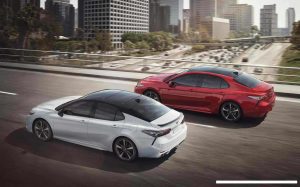
Other rivals include the Mazda6 and Hyundai Sonata.
Base price is $23,495 for the L trim equipped with the standard 2.5 liter engine and eight-speed automatic transmission. A top-of-the-line V6 XSE stickers for $34,950.
WHAT’S NEW
The 2018 Camry is a parking brake 180 – in attitude, appearance, performance – in a word, everything.
Almost nothing carries over except the name.
No longer just the sensible choice.
Powerful standard engine – without the turbo.
Optional V6 engine – a type of engine which rivals like the Accord, Mazda6 and Hyundai Sonata don’t offer anymore.
WHAT’S NOT SO GOOD
New Camry has about an inch less backseat legroom than the old Camry.
Trunk is smaller than before – and significantly smaller than new Accord’s.
Both of the Camry’s engines are direct-injected (like everyone else’s engines) and that means at least the potential for down-the-road issues with carbon build-up, which DI engines are prone to having.
The Camry offers both four and six-cylinder engines – neither of them force-fed engines.
Standard equipment is a 2.5 liter four cylinder that makes 206 hp – vs. 192 hp for the Honda Accord’s standard – and much smaller and turbocharged – 1.5 liter four.
The fact that the Camry’s engine is more powerful isn’t surprising given it’s almost twice the size of the Accord’s four.
What’s surprising is that the Toyota’s four is significantly more fuel-efficient, too: 29 city, 41 highway vs. 29 city, 35 highway for the 1.5 liter-equipped Accord. Honda does offer an efficiency upgrade that boosts this to 30 city and 38 highway, but it’s still not as good as the Camry’s 2.5 liter engine manages – and it costs extra.
The Camry gives you class-best fuel economy, standard.
If you want a stronger engine – a bigger engine – Camry’s got you covered. XLE and XLS trims can be ordered with a 301 hp 3.5 liter V6. It is stronger than any of its rivals’ optional turbocharged fours and gets the Camry to 60 in just over 5 seconds – best-in-class acceleration.
Mileage with the V6 is s 22 city, 33 highway – which isn’t far behind the mileage delivered by the Accord’s standard four.
And without resorting to turbocharging.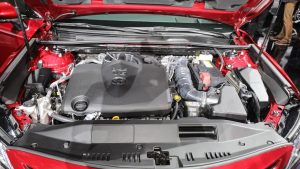
Not that there’s anything wrong with turbocharging. But it’s debatable whether it makes sense to turbocharge a family car engine. Turbocharging, like supercharging – which amounts to the same thing, the force-feeding of air to an engine – has historically been used as a way to increase the power of an already powerful engine; that engine usually powering a sporty car. Put another way, turbocharging (and supercharging) are power adders.
But they are now being resorted to as power-replacers.
To make up for the downsizing of engines – as in the case of the Accord and many other new cars. The engines are being made smaller to try to make them less thirsty – for the sake of complying with government fuel efficiency fatwas – with the turbos added to make power when necessary.
It’s good in theory – but in practice, the otherwise-underpowered/downsized engine is almost always on-boost, to make up for its lack of displacement. And – as in the case of the Accord’s 1.5 vs. the Camry’s 2.5 engine – using as much or even more gas than the larger engine.
Plus, you have the turbo – a piece of equipment that gets very hot and spins at extremely high RPM to produce the boost. Plus the peripherals, things like special exhaust plumbing, an intercooler and so on. No matter how well-designed these components may be, they are subject to wear and tear over time, just like any other component – and eventually, they wear out. And then you get to pay to repair/replace those parts.
The Camry hasn’t got those parts – so they’ll never wear out.
But the Camry does have direct injection.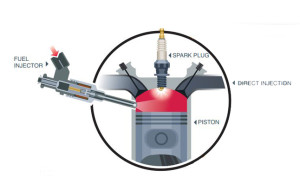
This is another affliction brought to us – forced upon us – by the government. Not directly. There is no mandate ordering Toyota and every other car company to replace the port fuel injection that’s been in use for decades with direct injection. But there are those fuel efficiency fatwas, which have to be complied with somehow.
DI is one way how. It is a much more complicated way of injecting fuel into the cylinders and one that also creates a problem which repair shops are already having to deal with – and customers paying for:
Carbon fouling of the intake valves.
Ordinarily, the backside of intake valves is kept free of carbon crud by the solvent action of the fuel, which is sprayed behind the valve and so washes it down and keeps it clean as the car is driven.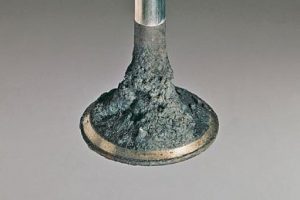
But direct-injection is different. Fuel is sprayed (at extremely high pressure) directly inside the cylinder, very much like an extra spark plug except instead of firing electrical current, it fires fuel. This does increase power – and there is also an efficiency gain of about 3-5 percent – but because there is no washing down of the backsides of the intake valves, they are prone to the accumulation of carbon deposits and once those deposits accumulate beyond a certain point, they can interfere with the valve sealing properly – and now the engine has to be de-carboned.
This can be done with solvent flushing or by partial engine disassembly, to get at the carbon and scrape it off.
It’s debatable whether DI is worth the trouble – from the standpoint of people buying cars and who will be the ones paying for the repairs.

But the government continues to demand higher-and-higher fuel economy and DI and downsized/turbo’d to make up for it engines are desperation solutions resorted to by an increasingly desperate car industry.
This is going to get much worse – and much more expensive – if the government raises fuel economy mandatory minimums to 50-plus MPG, which it is threatening to do. The question is, why does the government have the power to make such threats?
We buy the cars – and we pay for the gas they use. Doesn’t that make it our business?
Both Camry engines are paired with a new eight-speed automatic, replacing the previous six-speed automatic. The new transmission has deeper overdrive gearing to reduce engine RPM at cruising speed – in order to increase fuel efficiency.
The new transmission also has tighter gear spacing on the way to overdrive – which helps the car perform better, too.
The Camry has become a supercar.
It is quicker – and faster – than the Mustang Cobra R Ford loaned me back in 1995. That car was a race car, just barely street legal and sold only to people who possessed an SCCA road racing license. It not only didn’t have air conditioning – it didn’t even have back seats.
And it only had 300 hp – from a 5.8 liter V8.
The Camry not only blows its doors off, it has two more doors, back seats – and climate control AC.
The new Camry also has a wider track and longer wheelbase than the outgoing model, which improves the already superlative ride quality of this car. At the same time, steering response has been sharpened up and handling tightened up. The Camry was always the standout car in the class as far as comfort. Now it’s got moves.
There is also less noise.
Toyota went almost-Lexus with the insulation, including a dash silencer matt along the entire length of the firewall/cowl area, to keep the sounds of the engine inside the engine bay. “Vibration damping” material was slathered on the floorpans and upper and lower fender separators are used to further keep otherwise intrusive noise from intruding.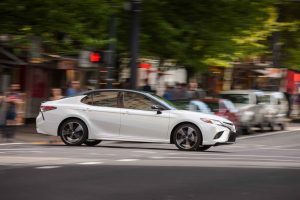
Forward visibility has been improved by lowering the hoodline 1.6 inches and by moving relocating the windshield A pillars and B pillars so they are less in the way of the driver’s line of sight
You sit a bit lower in the car, too – which enhances the sporty feel and will appeal to the younger demographic Toyota is hoping to attract.
It’s as pleasant as ever – but also more fun.
That’s a bingo, as Col. Landa from Inglorius Basterds might say.
The new Camry is lower and wider and – let’s just say it – sexier. This is deliberate policy. Toyota says they wanted people to be able to tell the Camry apart from other cars – and especially from older Camrys – from as far away as 200 yards.
They succeeded. This Camry is a looker.
Especially the SE and XSE trims, which get smoked tail-lights, Lexus-esque sculpted lower rocker panels and contrast color exterior accents, including the A pillars at either side of the windshield, flowing back to the roof and B pillars, too. Note also how the driver’s side door glass slopes down from the hoodline before sweeping toward the rear. This is another visibility enhancer, and it also just looks good.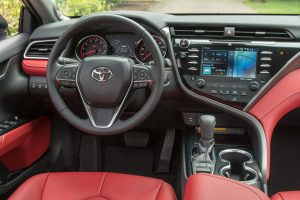
Inside, you’ll find an asymmetric and divided dashboard layout. A hooded pod with analog gauges for the driver with a kind of stylized, elongated “S” off to the right. This tapers all the way down to the center console almost like an embracing arm, clearly establishing the boundaries between the driver’s area of interest and the front seat passenger’s. On the other side of the S divider is the flush-mounted 8-inch LCD touchscreen which controls secondary-to-driving stuff – the audio/infotainment stuff – which are in turn controlled by the latest generation of Toyota’s Entune 3.0 Suite.
It’s slick, racy and very Lexus-y.
The new Camry is also the longest-so-far Camry at 192.7 inches bumper to bumper – which makes it almost a full-sized car in everything but name.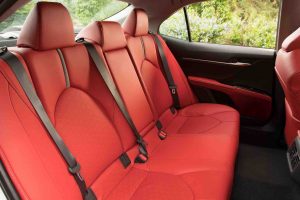
Front seat legroom increases to 42.1 inches vs. 41.6 inches last year. On the downside, backseat legroom declines slightly to 38 inches vs. 38.9 inches in last year’s Camry.
Also on the downside, the new car’s trunk gets a little smaller – 15.1 cubic feet vs. 15.4 cubic feet previously.
The now-more-practical Accord has 40.4 inches of backseat legroom and a 16.7 cubic foot trunk.
Sexiness has its price.
A hybrid version of the new Camry is on deck, too – and will deliver an estimated 52 MPG, an uptick of 30 percent over the previous-generation Camry hybrid. Unusually – radically – it will use two different battery packs, depending on the trim.
Base trims will have a lithium-ion battery pack, which is pretty much standard and par for the hybrid course. But SE and XLE trims will get a more powerful nickel metal hydride (Ni-MH) battery pack.
Neither version will get a plug – at least not at first.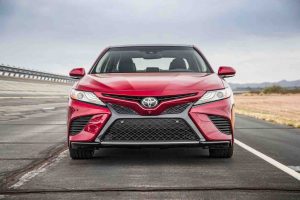
This, too, is radical in the sense that Toyota is playing it smart.
Plug in hybrids can operate on just their batteries (like dedicated electric cars) for 20-30 miles or so. One – the Chevy Volt – can go as far as 50-something miles on just electric power. But plug-ins are pricey and until (and unless) gas prices spike dramatically, convincing buyers to pay the several thousand dollars extra a plug-in costs vs. a regular hybrid is like trying to sell ice to Eskimos.
The hybrid version of the new Camry will be available this fall.
THE BOTTOM LINE
This radical redesign is just that – an automotive Hail Mary that Toyota hopes will not just connect with Millennial buyers but also rekindle waning interest in sedans, generally.
. . .
Got a question about cars – or anything else? Click on the “ask Eric” link and send ’em in!
If you like what you’ve found here, please consider supporting EPautos.
We depend on you to keep the wheels turning!
Our donate button is here.
If you prefer not to use PayPal, our mailing address is:
EPautos
721 Hummingbird Lane SE
Copper Hill, VA 24079
PS: EPautos magnets are free to those who send in $20 or more. My latest eBook is also available for your favorite price – free! Click here. If you find it useful, consider contributing a couple of bucks! 




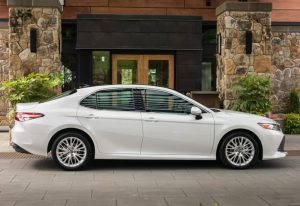

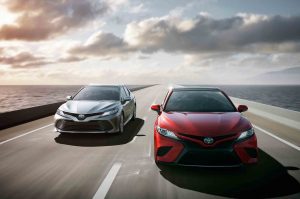
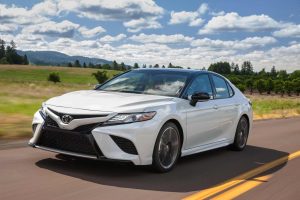
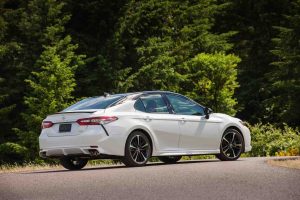
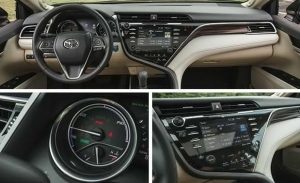







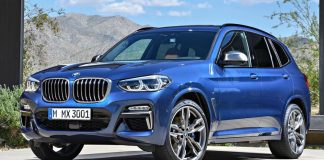
With direct injection, seems like a good idea to disconnect the EGR.
I wonder if this new Camry comes with random WOT? We all know they know what caused that, but now they won’t tell us if they fixed it or not. Nissan Maxima seems like a much better choice to me.
Maxima: “The CVT, however, detracts from the Maxima’s sports-sedan mission. Although it will mimic a typical automatic under heavy throttle, the CVT otherwise spoils the V-6’s fun.”
Eric, You often write of the issues with direct injection. I wonder just how big of a problem it is, and do some direct injection engines suffer from cruddy valves or do ALL direct injection get it at some point? Are there manufactures to avoid because of this?
I compliment Toyota in thier efforts to start making interesting cars again. Some of remember the MR2 and Supra, and of course the gorgeous 2000GT.
I can’t help but wonder how your typical Clover will react to this level of performance.
The Camry is like the official car of the ACA- American Clover Association.
It’s been 4 years or so since I drove a Toyota product, Lexus ES350. It was insanely dull, but frustrating as I liked the engine, and felt that there was an interesting car underneath itching to get out. But the car never gave me the precision feel that gives the driver confidence to push it a little.
Again I applaud Toyota for getting back to its roots on offering something that ratchets up the “fun to drive” quotient.
Hopefully thier base market will not reject this new direction.
5 seconds 0-60 in a family car with the V6? I can only imagine the conversations at the EPA or the Democratic Caucus Rooms in Congress:
Bureaucrat / Congresscritter: “It’s way too fast … we need to stop that gas guzzling NOW!”
Staff: “Umm … it still gets good MPGs.”
B / C: “The tax slaves aren’t supposed to have fun! That’s only for us! How do we stop this rape of Gaia?”
Amen, Jim!
The performance of cars today – even the most humble among them – is spectacular. But you have to be over 30 years old to really appreciate it. Those under 30 do not know a time when cars with V8 engines took 11 seconds to get to 60 – and those with four cylinder engines need 15 or more. 🙂
re this: “Front seat legroom increases to 42.1 inches vs. 41.6 inches last year. On the downside, backseat legroom declines slightly to 38 inches vs. 38.9 inches in last year’s Camry.”
Basically, they adjusted the front seat’s track so it can go back a half inch further into the rear seat’s legroom if needed, which is a good thing if you’re tall like me and need the room. If not, you can always slide the front seat forward a half inch — or more — to restore the leg room in the back.
The more significant result is a tiny 0.4 inch overall lessening in leg room for front and rear combined.
Time will tell. Toyota is taking a big risk with this “sporty” Camry. Their top selling Camry of the past was not “sporty”. In my view the current Camry is overdone – especially the grill.
I preferred the sleeper look of the past – with the high power V6, with standard “V” rated tires and a 140mph top end. And I’ll never forget the dysfunctional auto press, in unison, calling it “boring”. It was, in fact, exhilarating.
Hi Liberty,
I have always been a Camry fan – and pointed out that its performance (especially the V6 models) is anything but boring. And I am cheered by the fact that they did not retire the V6!
The Camry is the last car in this class that even offers one.
I’ve got two of the Camry/Lexus V6’s (3.5) in RAV4 twins (no direct injection). With 4WD the RAVs have better traction, outperforming the Camry V6 in many situations.
Some folks get kind of ticked for losing to a usually slow SUV :).
Hi Liberty,
These V6 Toyotas are among my favorite sleepers!
The carbon buildup you mention with direct injection….is that likely why my 2015 Accent’s engine shit the bed at 70k last month despite 3 years of regular oil changes and adhering to all their costly maintenance schedules? All Hyundai told me was that they heard it knocking while they were replacing the cat and the O2 sensors.
Hi Moose,
I will check and report back in re whether your car has DI; off to the top of my head, I am not sure. I know the new ones do. If your car has a badge that says “GDI” (Gas Direct Injection) yours does, too.
FYI: If the cat had to be replaced just three years out and after only 70,000 miles, it ought to be covered under warranty. Not just the Hyundai 10 year/100,000 mile coverage but the separate 100,000 mile emissions control warranty. Document all this extensively as having to replace a cat this early is indicative of some underlying issue and you don’t want to get stuck with the bill for the next cat replacement.
They covered the cat and replaced it with a remanufactured engine, I had to pay around $300 for the O2 sensors basically at part cost..I couldn’t bring aftermarket parts in and couldn’t take the car back off their lot to replace it myself, since they threatened to document it and basically would end up risking voiding my warranty.
So yeah. Still bizarre, at 70k
Just realized my sentences were only half formed there. Everything but the O2 sensors was under warranty–They replaced the whole exhaust manifold, and also the engine. They didn’t replace the cat with an engine hahaha. Tired.
Hi Moose,
A remanufactured engine? Why not a new Hyundai crate engine? What is the source of the remanufactured engine? I am disturbed reading this… and not just because of the remanufactured engine business. Having to replace the original engine in a three-year-old car does not bode well…
Yeah it is pretty disturbing. It sounds stupid but after getting stuck with the dealership loaner 2018 Elantra for a week, I realized I love my car and it is as new a model as I’m ever willing to own.
Throughout it’s inpatient stay I asked a lot of yes or no questions of the service advisorrrrr who did not really win over my confidence by the end of it all. But one of my questions was whether it was a remanufactured one and they said yes. I’ll double check the invoice in the glovebox in a bit maybe it goes into detail on the replacement engine origins.
I wonder if the car is still comfort-oriented or if they’ve gone the uncomfortable sport-sedan route with the suspension and seats. Glad Toyota hasn’t given up on the NA 4 and 6. That definitely makes the Camry distinct from the rest. It’s the only V6 in the mid-size segment I can think of that doesn’t have a CVT.
I wonder if they’ll make a raised wagon/crossover version of this. Something less expensive than the Highlander. I know the Venza didn’t work out but if sedans are actually falling out of favor I’d think they’d want to give the “Camry-type” buyer an option.
Perhaps Toyota abandoned the Venza class CUV because Honda doesn’t offer a product like that. So they’re not worried about losing such buyers to their primary competitor.
Also, as both RAV-4 and CRV continue to creep upmarket, the gap between them and the Highlander/Pilot class is getting smaller and smaller.
Morning, Mike!
Yes – and the RAV-4 and CRV4 continue to get … bigger, too.
Tell you what I’d like to see – but which Toyota will never offer here: A sportwagon version of the new Camry. That would eliminate the sedan issue of a too-small trunk and limited usefulness. And – my opinion – it would look good, too. But US Amerikans are weird; they do not like wagons, despite the many advantages and without the disadvantages of a jacked-up CUV!
In my mind, I keep picturing this new Camry and the new Accord as wagons. I really like both of these cars (Camry XSE V6 and Accord Touring 2.0T, of course) and would flip my lid if either came as a sportwagon. Drool…
It’s time to upgrade my wife from 15 years of driving Odyssey’s to driving something fun. Either of these models will do the trick, I think.
Ditto, Wally!
I’d love to see a wagon version of both. Honda already has an Accord wagon; but it’s not sold in the U.S., unfortunately….
Alas, like Lexus, the Camry’s face has gone garish to look “distinctive. (Not as ugly as Lexus, but bad enough.) A pity, because the side profile and tail design look great.
If I were in the market for a “performance” sedan at this approximate price (maybe a little higher,) I’d go Kia Stinger with the big motor. 🙂
Hi Mike,
I don’t like the “catfish” style that is now popular but in person, this car looks pretty good. The side view is the best, though – especially from slightly above…
Eric, glad to hear you concur about the “catfish” front ends. I was about to comment this car has a Cheshire Cat….fish look.
I don’t think this styling will wear well. In 5 years when the trends change again many will look at this ask “what was I thinking”
Sorry Eric but I think this looks too much like it was penned by a 21 year old Japanese Anime cartoonist who’s sniffed at one too many crack pipes, but that is the trend.
Too many past cars were overstyled where they looked cool and radical at first but after a few years started to look silly.
Sorry Eric but the front end of this car looks the roach commader from the old Freak Brothers comics – oops here I am dating myself.
But then my granddaughter thinks my Porsche looks like a tree frog LOL.
Hi Alex,
I don’t necessarily disagree with your argument – but I do think they had to do something to spice it up. Sedans aren’t selling well. Crossovers are eating their lunch. Since sedans can’t match the practicality of crossovers, they have to find some other way. This may be the way. Time will tell!
The unfortunate nature of the market I guess. I personally thought there was nothing wrong with the look of the old one, It was quite handsome and 10 year old one still looks fine and not dated at all but the cross-over juggernaut is changing the landscape
Hi Alex,
Handsome, but very bland. That isn’t necessarily a bad thing, if you’re marketing to menopausal ladies and such – which is a big chunk of the market, no doubt. Problem is, the old ladies are aging out of the market and Toyota has to entice younger women (and men) for this car to thrive, or even survive.
I think they have done a capital job!
Now, about that wagon . . .
Alex,the Furry Freak Brothers bring back lots of memories.
Wis I still had a copy or two.
Maybe I can find a dvd of Felix the Cat.
I have a box of them in great shape, they are as funny today as they were in 1970
This is the first or second new sedan I have been interested in for years. I like that his car also comes with a standard ignition KEY. None of the push start bullshit. Good job to Toyota.
Amen, Swamp!
Now, if only they had managed to avoid the direct injection…
They added port injection
I had a 97 2.2L camry LE. I hated it at the time. It was dead reliable and under powered. It finally died after a timing belt failure. I was redlining at every exit ramp and the shaft oil seal was leaking oil. The high revs with the oily timing belt caused a slip and major engine failure finally at 260k miles. If i had not been living in an apartment i would’ve been able to fix it at the time. I bought a 02 subaru wrx to replace it.
The new motor has both direct injection and port injection. Toyota motors wont be getting the carbon build up that direct injection only cars (i.e. hyundai, ford) get.
Seen a few of these at work. I like it. Reverse the feminization trend.